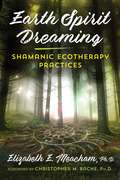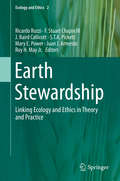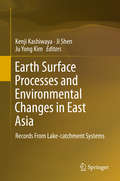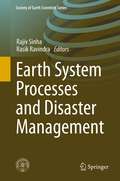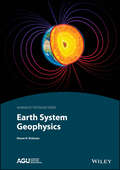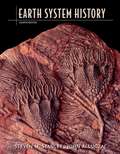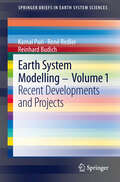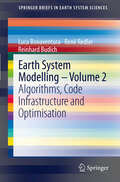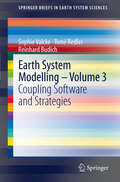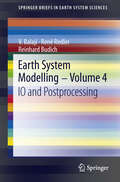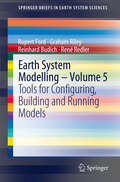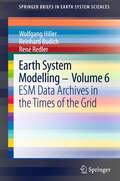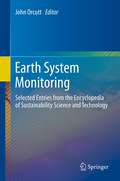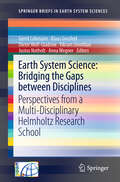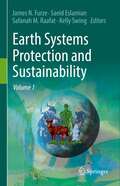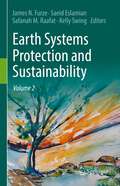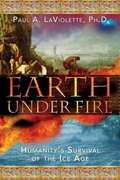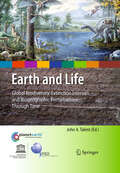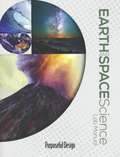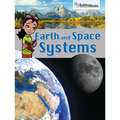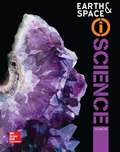- Table View
- List View
Earth Spirit Dreaming: Shamanic Ecotherapy Practices
by Elizabeth E. MeachamA guide to co-creating a healing vision for humanity and the Earth through nature-connected shamanic rituals • Explains the Earth Spirit Dreaming process for rebirthing inherent shamanic abilities with dozens of practices in three categories: Earth-connecting practices, Spirit-connecting practices, and Dream-connecting practices • Provides experiential exercises to foster interactions with the intelligences and elemental energies of nature and the Spirit realm, realign you with the rhythms and flow of life, and co-create a healing dream for humanity and all of life on our planet • Contains step-by-step directions for connecting with the light guides of the planet for guidance and healing Humanity has become profoundly disconnected from the web of life on Earth as well as from nature as a whole. In this practical guide, Elizabeth E. Meacham details her field-tested method of shamanic ecotherapy practices to resolve this centuries-long trend toward disconnection. Through these practices, you will learn how to reconnect to Earth&’s systems and help restore health and balance to people and the planet. Translating transformative ideas from visionary environmental thinkers into engaging shamanic rituals for profound spiritual growth, Meacham offers dozens of practices in three categories: Earth-connecting practices, Spirit-connecting practices, and Dream-connecting practices. Building on one another, the exercises open channels to allow you to directly experience the intelligences of the Earth and Spirit realms, rebirth your inherent shamanic abilities, realign you with the rhythms and flow of life, and reclaim your ancestral power for co-creating a healing dream for our species and all of life on our planetary home. Guiding the reader through a progressively deepening journey toward connection with ourselves, each other, and the consciousness of our biosphere, the practices also invite profound mindfulness, as we work to hold a vision of connection with the Earth and Spirit realms, while choosing consciously to focus on joy, beauty, gratitude, love, and healing. Illuminating a shamanic awakening within Western culture at the dawn of an ecological age, Earth Spirit Dreaming reveals how the birth of a global consciousness of healing depends upon our commitment to individual and collective spiritual evolution. Calling us back to our shamanic heritage of a living nature spirituality, this manual offers much needed guidance on the essential journey back to an intimate love of Earth.
Earth Spirit Living
by Ann Marie HolmesEarth Spirit Living is a revolutionary approach to lifestyle design and personal space. Author Ann Marie Holmes, an expert on earth energy systems, reveals that by picking up subtle cues from the natural world, we can create healthy, enjoyable, and sustainable living spaces. She shows how we can effectively incorporate principles of sacred geometry, human intuition, and the power of space, shape, and layout to become aware of -- and collaborate with -- the earth's energies. Perfect for homeowners, renters, business owners, professional designers, and builders, Earth Spirit Living illuminates the benefits of living in cooperation with our environment, including: * a more comfortable home * increased effectiveness in your work * healthier, calmer living conditions * enhanced work and personal relationships * improved prosperity * smoother construction or remodeling process Insightful illustrations, ceremonies, cures, attunements, and visualizations will help you hone your natural instincts and strengthen your connection to your physical space. With client stories and personal anecdotes, Holmes guides you on the journey toward a balanced life and living space that harnesses the energy and wisdom of nature.
Earth Stewardship
by J. Baird Callicott F. Stuart Chapin III Ricardo Rozzi Juan J. Armesto S.T.A. Pickett Mary E. Power Roy H. May Jr.This book advances Earth Stewardship toward a planetary scale, presenting a range of ecological worldviews, practices, and institutions in different parts of the world and to use them as the basis for considering what we could learn from one another, and what we could do together. Today, inter-hemispheric, intercultural, and transdisciplinary collaborations for Earth Stewardship are an imperative. Chapters document pathways that are being forged by socio-ecological research networks, religious alliances, policy actions, environmental citizenship and participation, and new forms of conservation, based on both traditional and contemporary ecological knowledge and values. "The Earth Stewardship Initiative of the Ecological Society of America fosters practices to provide a stable basis for civilization in the future. Biocultural ethic emphasizes that we are co-inhabitants in the natural world; no matter how complex our inventions may become" (Peter Raven).
Earth Surface Processes and Environmental Changes in East Asia
by Kenji Kashiwaya Ji Shen Ju Yong KimThis book examines relationships between climate-hydrological changes and other phenomena including land use and natural disasters during the Holocene and recent past. In particular, periods of rapid climatic shifts such as global warming and global cooling are examined through paleohydrological and other studies of various lake-catchment systems in East Asia, from Mongolia in the north to Taiwan in the south. A number of different research techniques are used in the work presented here, including sediment analysis and optically stimulated luminescence dating and the reader learns how the lake-catchment system functions as a "proxy observatory" for past and present environmental monitoring. The lake catchments studied by the authors of this volume are under similar climatic conditions, i. e. , under the East Asia monsoon, with some systematic difference in climatic factors. Both proxy and observation data are available for the surrounding countries' provisions against natural disasters that are related to climate-hydrological events and readers will see how present instrumental observation data can be connected to past proxy data (sediment information) in the system.
Earth System Processes and Disaster Management
by Rajiv Sinha Rasik RavindraOne of the fundamental goals of earth system science research is to adopt a more holistic view of the earth as a 'system' comprising different domains. The Society of Earth Scientists has brought out this multidisciplinary publication to emphasize the need of an integrated approach to understand the Earth system. It focuses on natural disasters and, in particular, on climate change and its effects in Asia and understanding the significance of these developments within the context of the paleo-climatic record. The later sections of the book then focus on other types of natural disasters as well as those induced by human interaction with our environment.
Earth System Geophysics (AGU Advanced Textbooks)
by Steven R. DickmanEarth System Geophysics Geophysics helps us understand how our planet works by connecting complex real-world phenomena with fundamental physical laws. It provides the tools, both conceptual and quantitative, for understanding interactions between the different components of the Earth System: the solid earth, oceans, atmosphere, and biosphere. Earth System Geophysics is a comprehensive textbook for upper-level undergraduate and graduate students in the Earth sciences that uses Earth System Science as the framework for learning about geophysics. About this volume: Presents convection as the underlying paradigm that drives the Earth System Uses math and physics in an accessible way to understand processes on and within the Earth Frames natural processes and events in terms of cause and effect Builds gradually from basic to advanced concepts and equations Develops quantitative skills through applied examples Heavily referenced, allowing students to pursue topics in greater depth Relevant for students from across the physical sciences and engineering The American Geophysical Union promotes discovery in Earth and space science for the benefit of humanity. Its publications disseminate scientific knowledge and provide resources for researchers, students, and professionals.
Earth System History (Fourth Edition)
by Steven M. Stanley John A. LuczajThe thoroughly updated new edition includes important new coverage on mass extinctions, climate change, and Proterozoic history, plus a range of interactive studying and teaching tools.
Earth System Modelling - Volume 1
by Reinhard Budich Kamal Puri René RedlerCollected articles in this series are dedicated to the development and use of software for earth system modelling and aims at bridging the gap between IT solutions and climate science. The particular topic covered in this volume addresses the usefulness of coupling infrastructures and data management, strategies and tools for pre- and post-processing, and coupling software and strategies in regional and global coupled climate models. This first part in the series of 6 books sets the scene for the following volumes.
Earth System Modelling - Volume 2
by Reinhard Budich René Redler Luca BonaventuraCollected articles in this series are dedicated to the development and use of software for earth system modelling and aims at bridging the gap between IT solutions and climate science. The particular topic covered in this volume addresses the historical development, state of the art and future perspectives of the mathematical techniques employed for numerical approximation of the equations describing atmospheric and oceanic motion. Furthermore, it describes the main computer science and software engineering strategies employed to turn these mathematical methods into effective tools for understanding earth's climate and forecasting its evolution. These methods and the resulting computer algorithms lie at the core of earth system models and are essential for their effectiveness and predictive skill.
Earth System Modelling - Volume 3
by Reinhard Budich René Redler Sophie ValckeCollected articles in this series are dedicated to the development and use of software for earth system modelling and aims at bridging the gap between IT solutions and climate science. The particular topic covered in this volume addresses the major coupling software developed and used in the climate modelling community.
Earth System Modelling - Volume 4
by Reinhard Budich René Redler V. BalajiCollected articles in this series are dedicated to the development and use of software for earth system modelling and aims at bridging the gap between IT solutions and climate science. The particular topic covered in this volume addresses the issue of data input/output and post-processing in the context of Earth system modeling, with an emphasis on parallel I/O, storage management and analysis subsystems for very large scale data requirements.
Earth System Modelling - Volume 5
by Reinhard Budich René Redler Graham Riley Rupert FordCollected articles in this series are dedicated to the development and use of software for earth system modelling and aims at bridging the gap between IT solutions and climate science. The particular topic covered in this volume addresses the process of configuring, building, and running earth system models. Earth system models are typically a collection of interacting computer codes (often called components) which together simulate the earth system. Each code component is written to model some physical process which forms part of the earth system (such as the Ocean). This book is concerned with the source code version control of these code components, the configuration of these components into earth system models, the creation of executable(s) from the component source code and related libraries and the running and monitoring of the resultant executables on the available hardware.
Earth System Modelling - Volume 6: ESM Data Archives in the Times of the Grid
by Reinhard Budich René Redler Wolfgang HillerCollected articles in this series are dedicated to the development and use of software for earth system modelling and aims at bridging the gap between IT solutions and climate science. The particular topic covered in this volume addresses the Grid software which has become an important enabling technology for several national climate community Grids that led to a new dimension of distributed data access and pre- and post-processing capabilities worldwide.
Earth System Monitoring
by John OrcuttModern Earth System Monitoring represents a fundamental change in the way scientists study the Earth System. In Oceanography, for the past two centuries, ships have provided the platforms for observing. Expeditions on the continents and Earth's poles are land-based analogues. Fundamental understanding of current systems, climate, natural hazards, and ecosystems has been greatly advanced. While these approaches have been remarkably successful, the need to establish measurements over time can only be made using Earth observations and observatories with exacting standards and continuous data. The 19 peer-reviewed contributions in this volume provide early insights into this emerging view of Earth in both space and time in which change is a critical component of our growing understanding.
Earth System Science: Bridging the Gaps between Disciplines
by Klaus Grosfeld Anna Wegner Vikram Unnithan Dieter Wolf-Gladrow Justus Notholt Gerrit LohmannEarth system science is traditionally split into various disciplines (Geology, Physics, Meteorology, Oceanography, Biology etc.) and several sub-disciplines. Overall, the diversity of expertise provides a solid base for interdisciplinary research. However, gaining holistic insights into the Earth system requires the integration of observations, paleoclimate data, analysis tools and modeling. These different approaches of Earth system science are rooted in various disciplines that cut across a broad range of timescales. It is, therefore, necessary to link these disciplines at a relatively early stage in PhD programs. The linking of 'data and modeling', as it is the special emphasis in our graduate school, enables graduate students from a variety of disciplines to cooperate and exchange views on the common theme of Earth system science, which leads to a better understanding of processes within a global context.
Earth Systems Protection and Sustainability: Volume 1
by James N. Furze Kelly Swing Saeid Eslamian Safanah M. RaafatEarth Systems Protection and Sustainability qualifies imperatives and discusses the use of mathematical approaches to assess and achieve sustainability in threatened and vulnerable Earth systems globally. Mathematical advances in this context include both operational and Boolean methods, as well as linguistic, logic-based Bayesian approaches and generative mathematics relevant to scenario formation. The mathematic methods are refined into functional areas and deeper learning, which enable the use of searching algorithms to achieve optimal solutions for the circular nature and application of sustainability. Pertinent sections and synergistic elements are covered in order to synthesize key informative nodes, advising of the very real dangers facing planet Earth and its biodiversity. Each volume stands in its own right. Analytical and scientific chapters are blended with social resilience and socio-economic development consideration, thus enabling the settings of sustainability within varying scenarios of climatic forces and species dynamics.Volume 1 focuses on ground-breaking evolutionary expansion assisting with life’s continuation on Earth, sustainable management of pathogens and halophyte uses in agroecology, bioremediation methods in drilling waste management, conservation and sustainability of diversity, climate change mitigation strategies, displacement management in a large scale ongoing crisis, risk reduction and management policy, sustainably intelligent-driven markets, sustainability consensus in an uncertain environment and path planning in static and dynamic environments. Pictorial contributions made from across the world refine particularly urgent problems for attention, and provide solutions and methods of environmental sustainability operated in communities, complementing the descriptive chapter sections. Both volumes are targeted for a global audience of academic, professional, classroom, governmental, unit and community members, and seek to include all sectors to ensure ongoing and comprehensive Earth Systems Protection.
Earth Systems Protection and Sustainability: Volume 2
by James N. Furze Kelly Swing Saeid Eslamian Safanah M. RaafatEarth Systems Protection and Sustainability authorises imperatives to achieve sustainability and protect our threatened and vulnerable Earth. Mathematical advances in context incorporate operational and Boolean, as well as linguistic, logic-based Bayesian, and generative methods for scenario formation. Functional areas and deeper learning enable the use of searching algorithms, proffering optimal solutions for the circular nature of sustainability in natural ecosystems and human dominated settings. Key informative nodes are provided in the hope that we may moderate the very real dangers facing planet Earth and its biodiversity. An arena of insightful chapters is blended with social resilience and socio-economic development coverage, accentuating integrity, protection and sustainability within divergent climatic forces and species dynamics on Earth. Volume 2 focuses on bioaccumulation; climate change and resilience for co-operative socio-economic and ecosystem management via policy frameworks across sectors; mathematical modelling of freshwater in coastal regions in arid and semi-arid zones; decision making in natural disasters; peat solidification for environmentally sustainable geotechnical engineering; green energy conversion; flood risk mapping; rainfall analysis; exposure, safety, and security amidst increasing environmental contamination; remote handling vehicles; wind turbines; and deep learning and its environmental applications. Earth Systems Protection and Sustainability is addressed globally to communities, schools and researchers in professional, governmental and unit operations; descriptive and illustrative sections include all sectors to ensure Earth Systems Protection as our capacity reaches an unsustainable climax.
Earth Systems, an Earth Science Course
by CurrikiThe Open Source Earth Science course has been organized to meet the CA Science Standards for Earth Sciences in grades 9 - 10, as adopted by the California State Board of Education. This course is part of a set of collections that contain additional Earth Science resources on Curriki that can be accessed at www.curriki.org.
Earth Under Fire: Humanity's Survival of the Ice Age
by Paul A. LavioletteAnother book in a series of books on quantum physics exploring the construct of our universe. this book covers the coming galactic changes.
Earth and Life
by John A. TalentThis volume focuses on the broad pattern of increasing biodiversity through time, and recurrent events of minor and major ecosphere reorganization. Intense scrutiny is devoted to the pattern of physical (including isotopic), sedimentary and biotic circumstances through the time intervals during which life crises occurred. These events affected terrestrial, lacustrine and estuarine ecosystems, locally and globally, but have affected continental shelf ecosystems and even deep ocean ecosystems. The pattern of these events is the backdrop against which modelling the pattern of future environmental change needs to be evaluated.
Earth and Space Science
by Kristine LindsayEarth and space are two unique systems, combinations of parts that work together. Earth science is the study of these two systems and how they are related.
Earth and Space Science Lab Manual (Purposeful Design Science Series)
by Purposeful Design PublicationsThis lab manual is designed to be used with the rest of the ACSI / Purposeful Design Earth and Space Science curriculum. A variety of worksheets and activities are included. Students will conduct experiments and record their hypothesis and give their analysis and conclusions; complete various charts, use maps, and more.
Earth and Space Science, First Student Edition
by Purposeful Design PublicationsEarth and Space! This textbook guides your child through a study of geology, oceanography, meteorology, astronomy, and environmental science. A thorough study of rocks, soil, and fossils will give your child ample proofs that this earth was created by God and not evolutionary processes.
Earth and Space Systems: Below-Grade Reader (Building Blocks of Science Literacy Series)
by Nicholas MooreLexile range: 610L–760L. Earth and Space Systems Below-Grade Reader gets kids thinking about Earth's place in space and its major systems. Topics include: Earth's Place in Space; Earth's Major Systems; Earth's Oceans; the Science and Engineering Practices of analyzing data; and learning about the career of a hydrologist.
